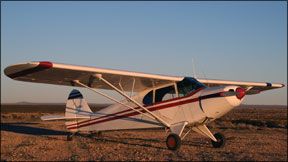While much of the recent chatter among used-airplane market watchers involves the seemingly bottomless price plunges for plastic and metal cross-country platforms, the rag-and-tube market isn’t down nearly as much. Part of the reason, of course, is these airplanes never appreciated like big-bore singles. Another reason is constant demand for simpler, slower, inexpensive fun airplanes capable, in a pinch, of actually going somewhere, albeit sedately and only in good weather.
The steady growth in light sport aircraft popularity demonstrates the depth of a market for new low-and-slow airplanes, even if many of them first see service as trainers. But the price point for a new LSA can easily scare away the buyer in search of a simple, fun airplane, leading them to consider older, classic airplanes of relatively simple fabric and tube construction.
Any time fabric-covered airplanes are considered, Pipers classic J-3 Cub and PA-18 Super Cub usually make the list. Sometimes overlooked is the PA-12 Super Cruiser, which falls somewhere between those two icons, yet provides a low-cost entry into the world of utility and fun flying. For many missions, the Super Cruiser is a reasonable and less-expensive alternative to the Super Cub, affording greater speed, comfort and flexibility than the J-3.
One downside, of course, is these early Pipers are more than 50 years old-while parts availability is still good, finding a competent mechanic familiar with tube-and-fabric designs to stay on top of mechanical concerns is critical.
Another point is the PA-12 isn’t LSA-eligible, meaning you cant fly it without a medical. But that has the benefit of keeping down prices, as contemporary models meeting the LSA definition seem to be in greater demand.
History
The PA-12 Super Cruisers deep roots were planted in 1939, beginning with the three-seat J-5 Cub Cruiser, powered by a 75-HP engine. Sources differ on the powerplant manufacturer; as few as two copies may have been the production run. The J-5A, also known as a Cub Cruiser, quickly followed, with a 75-HP Continental A-75-8 up front. The J-5B Cub Cruiser model wasnt far behind, powered by a Lycoming GO-145-C2, also of 75 HP. Along the way, a J-5A-80, with an 80-HP Continental A-80-8 also was offered, gaining certification in July 1942. The type certificate also includes 85-, 90- and 104-HP engines as options for the J-5A and -B, but its not known how many airframes left the factory with these powerplants.
The early J-5A/B models basically were improved J-3s, with wider cabins, room for more instruments and a two-person rear seat. Gross weight for the three J-5 models was 1450 pounds, with fuel capacity starting at 19 gallons and increasing to 25 gallons after serial number 5-784. Solo flights were conducted from the front seat, unlike the J-3. A single 18-gallon fuel tank was mounted in the right wing, along with header tanks of one, two or seven gallons, depending on model. Another 18-gallon tank was optionally available on the J-5C for the left wing.
Piper had a few leftover J-5 orders from before the war and used the basic design to certify the J-5C in December 1942, which-according to the FAA type certificate-was a J-5A with redesigned landing gear and engine installation. Two additional models, the AE-1 and HE-1, were air-ambulance versions sold to the military. They were the same as the J-5C, again according to the FAA type certificate, except for removing the rear seat and baggage compartment, plus the addition of fuselage strengthening and minor rudder and aileron control system changes.
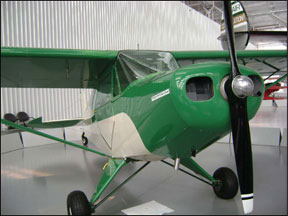
With the end of the war, every aircraft manufacturer looked at ways to use its bloated inventory of parts and raw materials to produce civilian airplanes, and Piper was no exception. By that time, Piper had substantial experience with the de sign and rolled out a highly modified J-5C in October 1945 as a prototype for the planned Super Cruiser. The prototype was used for flight testing, after which it was destroyed. The aircraft was certified in the normal and utility categories with wheels and in the normal category for seaplane operations. Around this time, Piper also abandoned model designations beginning with a J, ushering in the PA numbering system.
Production of the new PA-12 Super Cruiser began with serial number 12-2 at Pipers Lock Haven, Pennsylvania, factory in February 1946 and continued until May 1948. A Lycoming O-235-C, blasting out 100 HP, provided power. In addition, 234 aircraft were built in Ponca City, Oklahoma, in 1947 and early 1948, after which the Ponca City plant was closed. The decision to produce airplanes in two plants was premature at best: Piper didnt get certification for the airplane until March 1947-13 months after production began.
That was right before the mid-1947 post-war aircraft boom went bust, leaving Piper with a field full of unsold PA-11s and PA-12s as the company struggled to stay afloat. In all, Piper assigned serial numbers to some 4000 PA-12 Super Cruisers.
Two examples of the PA-12 made the history books. On August 9, 1947, Clifford V. Evans and George Truman departed Teterboro, New Jersey, in two modified Super Cruisers. The two were officers in the U.S. Air Force Reserve and worked as flight instructors at the College Park Airport in College Park, Maryland. More than 22,000 miles later, both airplanes and their pilots returned to Teterboro on December 10, 1947, having flown around the world.
Their circumnavigation required 55 flights and resulted in only one mishap: A tailwheel was damaged on landing. Evans piloted a PA-12 named “City of Wash ington,” which is now property of the Smithsonian. Truman flew the “City of the Angels,” which resides at the Piper Aviation Museum in Lock Haven, Pennsylvania. Their flight marked the first time a light personal airplane circled the globe and came to an end just months before Piper stopped making PA-12 Super Cruisers.
Features
The changes to the J-5 warranting a new type certificate for the PA-12 were primarily under the skin. The fuselage is nearly identical to the J-5, but the wing spars changed from wood to metal. The tail surfaces were exactly the same as in the J-5s. Gross weight went to a hefty 1750 pounds when flown in the Normal category; operators were restricted to 1500 pounds when flying the PA-12 as a Utility airplane.
There were a few aerodynamic cleanups, with the wing struts getting aluminum fairings at the top and bottom and fairings added at the top of the jury struts. The landing gear received new fairings, also, at the fuselage attach fittings and the shock cords were relocated up in the fuselage under the pilots seat, where three rings were used on each side. The windshield became a one-piece affair and optional wheel fairings were offered. In addition, each wing got a 19-gallon metal tank fully enclosed with a metal skin on top of the wing.
Late in production, Piper made available Lycomings O-235-C1, which upped the power on tap to 108 HP continuous, plus one minute at 2800 RPM that produced 115 HP.
Standard equipment on the PA-12 often was, at the time, optional or unavailable on aircraft from Pipers competitors. This included an electrical system with a starter, navigation lights and a landing light. Radios soon followed. Of course, the skys the limit when it comes to equipment you might find on a Super Cruiser today.
Handling
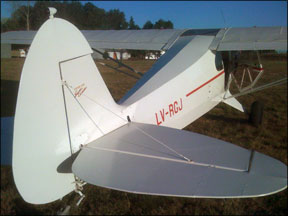
Flying the PA-12 has been likened to a J-3 on steroids-like modern pilots might feel transitioning from a Cessna 150 to a Skyhawk. The controls are more responsive than the J-3 and the additional ponies on tap mean the PA-12 is capable of primary training, but is well-suited to a more advanced pilot.
The airplane is heavy in pitch, making it essential the pilot spin the trim handle located on the left sidewall. When trimmed, pitch heaviness means stability, but any change in RPM requires an immediate trim change to avoid arm-wrestling the airplane.
Taxiing is typical taildragger. The short front gear struts improve visibility somewhat. Its different from most taildraggers, however, in that the wings angle of incidence is flat enough that a full-stall landing is not possible without landing tailwheel first. That means the airplane tends to float on landing and will take off in either the three-point or tail-high position.
Using trim on approach helps solve a couple of problems. Proper trim yields about 70 MPH on downwind and base. Crank the nose up a bit on final, reducing speed to about 55 MPH, and you’ll likely be just about full nose-up on the trim wheel if flying solo from the front. The airplane will practically land itself at about 42 MPH.
Brakes are adequate, but the airplanes short landing rolls are such that brakes arent needed much on the ground other than to make pivoting turns or short-field landings.
One aspect of the airplanes handling demands attention, particularly for those who fly to the limits of the airplanes endurance. The fuel lines run from the back of the fuel tanks, and during descent the tanks can unport if the fuel quantity is low. Unfortunately, lousy fuel gauges mean you don’t really know when that will happen.
The fuel gauges are glass sight tubes that extend downward from the wing. Floats and wires within the glass tube are supposed to indicate quantity, but like most fuel gauges of the era they are so inaccurate as to be ignored.
In an effort to reduce the fuel unporting problem, Piper added a two-gallon header tank between the cabin sidewall and the outer cowl.
The tank is located in the fuel line between the tanks and the gascolator and holds only a small quantity of fuel. In later airplanes, the leak-prone tank was removed, further increasing the odds of unporting. The fuel port situation means pilots should plan for fairly leisurely descents when fuel is low, especially when descending from relatively high altitudes.
With the original 100-HP engine, the Super Cruiser cruises at about 105 MPH. The later engine doesnt add to the cruise speed, but shortens the takeoff distance and adds about 100 FPM to the climb rate.
The book puts the takeoff run at 720 feet and the landing roll at 470 feet in the Normal category. The maximum useful load is about 800 pounds per the factory and perhaps 750 pounds in a real airplane. That gives enough useful load to carry three FAA-standard adults and full fuel, or two people and more than you can fit in the
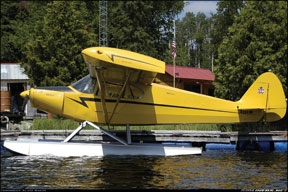
baggage compartment. With full fuel, the Super Cruiser has a range of about 600 miles, burning 5.8 to 6 gallons per hour.
The front seat is small and a little narrow, but its very comfortable for even large people. The seating position is good, with more than adequate legroom. All controls are easily within reach. The biggest front-seat shortcoming is that getting in and out requires some gymnastics due to the position of the seat we’ll forward of the door.
Rear seat room is outstanding for one person and cozy for two. The two-place rear seat is 31 inches wide at the hip and 33.5 inches at the shoulder. To make life better for rear-seaters, the aft stick comes out easily.
Factory-standard seats originally were vinyl-covered inflatable cushions, which later gave way to a more conventional vinyl-covered horsehair cushion. Cabin ventilation is good. The left side window slides open on the ground or in flight. The cabin heater works well, too. As the airplane came from the factory, the heating vents doubled as fresh-air vents when the heater was turned off.
Compared to the prototype J-5C, the Super Cruiser boasts an enlarged instrument panel, with factory-originals sporting a two-tone hammertone paint job. The panel was designed with optional instruments in mind, although by modern standards, its extremely small.
Electrical switches were housed in a metal panel on the right sidewall, just forward of the door. Navigation lights were standard and a landing light was optional. The Cub-standard heel brakes included a cable linkage to a handle under the right side of the panel that served to actuate the parking brakes.
Fuel System
As noted, the fuel system was changed to delete the small header tank early in the production cycle. Along with the header tank, the original configuration included two fuel shutoff valves on the lower left forward sidewall. The forward valve stopped the fuel flow entirely just downstream of the header tank. The aft valve shut off flow from the right wing and was supposed to be open only in level flight.
When the header tank was removed, the valves were relocated farther aft. The top valve controlled the right tank and the lower valve controlled the left tank. Both were intended to remain on normally and to be used to correct a fuel imbalance or shut off the fuel in case of emergency or maintenance.
The fuel tanks themselves have caused their share of problems. Made of thin-walled steel known as “ternplate,” the tanks were soldered together. Inside, two
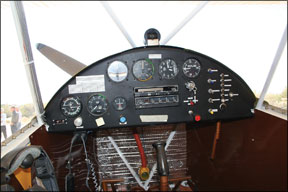
longitudinal baffles were spot-welded to the upper and lower skins of the tank. After decades of fuel sloshing inside the tanks, the baffle welds can tear loose. In addition, the seams can crack, leading to fuel leaks. The tanks can be removed, purged and re-soldered, but many owners opt to use epoxy patches as a more durable and practical solution.
Maintenance
As one should expect with any old airframe, there are several areas where close attention to maintenance is important. The airplane originally used wood in the wing tips and steel tubes in the trailing edge of the ailerons and wing struts. Weep holes in the fabric are crucial to preventing moisture from deteriorating the internal structures, and its a good idea to periodically inspect underneath the fabric.
The wing struts have had many service letters and ADs against them over the years, mainly because of internal corrosion that eats through them from the inside out, but also due to fatigue on the bottom end of the steel strut. A new-style sealed strut is available from Univair Aircraft Corp. in Aurora, Colorado, to resolve the corrosion problem. The struts also feature a larger fork at the bottom to preclude cracking.
Although the basic PA-12 airframe hasnt had an AD issued against it in 10 years, the same cannot be said of the Lycoming engines powering it. Also, some repetitive ADs we came across may have terminating actions developed for them, the paperwork for which is perhaps buried in the fine print of a Piper service bulletin or STC from a third-party vendor
The landing gear assemblies on some of the earlier models also have had their share of troubles. They had a thin steel strap running from the inboard end of the axle to the inboard end of the main gear tube where the shock cords are. The welds at each end of the strap were prone to cracking, so Piper modified the part in the field by welding a streamlined tube over the strap and beefing up both ends. Later, the gear was redesigned entirely. Otherwise, the gear is typical early Piper fixed gear: trouble-free.
There also have been reports of cracks in the aileron bellcranks, which are usually traced to improper torquing of the cast aluminum components by a ham-handed mechanic or uninformed pilot/owner. Aileron hinge brackets have also been occasional trouble spots, with cracks spreading where the hinge attaches the aileron to the trailing edge of the wing. Beef-up kits are available from Univair.
Additional inspections should be made of the rudder pedals. The pedal return springs are wrapped around a pivot tube, but the springs are hard steel and the tube is thin-walled steel. Throw in some dirt from the floor, and the springs can wear through the steel tubes over time.
Mods, User Group
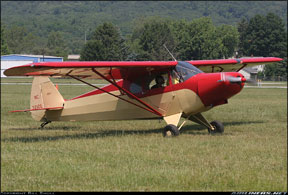
By some accounts, the PA-12 boasts more mods than any of the other vintage Pipers. Hundreds of STCs have been issued for PA-12s, including vortex generators, larger vertical stabilizers, flaps, 24-gallon wing tanks, and metal or fiberglass wing skins-as we’ll as a variety of engine and propeller combinations.
Additionally, STCs are available for Cleveland and Bodell brakes, installing skis or floats, PA-18 Super Cub landing gear, tundra tires and various tailwheels. You can also get extended baggage bays, left side doors, door removal, increased gross weight, various tail surfaces and auto fuel.
Approved powerplants include Lycoming engines with 125, 135, 150, 160 and 180 HP. Boosting the power so dramatically usually includes staples such as oil coolers, but also can mean larger, balanced control surfaces, beefed up cowlings and other components that will get beaten up by the stronger prop wash.
Univair Aircraft Corp. (www.univair.com) is a primary source of PA-12 parts, both original-manufacture and those made under the companys own PMA. Univair offers both print catalogs and a Web-based search engine to narrow down parts applicability. The company also reprints original manuals, parts catalogs and all of the factorys service bulletins, service letters and service memos. Aircraft Spruce & Specialty (www.aircraftspruce.com) is another good source for PA-12 parts.
The Cub Club (www.cubclub.org) is one of the largest of the type clubs for Piper Cubs, and the Super Cruiser squarely falls into the Cub family. Membership includes a newsletter with technical advice and parts information. Another good source of technical information is Charlie Center of Crosswind STOL in Wasilla, Alaska, who can be reached at 907-376-8069.
Piper no longer holds the type certificates for many of its older designs, the J-5 and PA-12 series included. FS 2003 Corporation, based in Bellingham, Washington, but owned by British Columbia-based Cub Parts (250-549-1612) is the current PA-12 certificate holder.
Owner Comments
My family owns a 1946 PA-12 Super Cruiser that I fly to and from our ranches to check water, fences, and count livestock. The ranches are located over 100 NM apart, so the PA-12 is a cost-effective and efficient way of transportation. Our PA-12 is equipped with the original Lycoming O-235 of 100 HP; it burns 6 GPH at 2400 RPM and cruises at 110 MPH. That math comes out to about 18 MPG. I can fly to both ranches and check all of the water and be back in time for dinner, compared to driving my 4×4 diesel pickup, that gets about 16 MPH and takes almost a week to do the same task.
We have a few dirt strips scattered across some 90,000 acres of land we ranch, and I often land in open areas of the pastures. The PA-12 handles this very well. The Super Cruiser is not only a good ranch airplane, it is also a good cross-country plane, hence the name “Super Cruiser.” It has 38 gallons useable fuel giving it a much longer range than the older J-3 and J-4 Cubs.
The elevation here is 4500 feet and on a hot summer day the density altitude can be over 8000 feet. Therefore, the PA-12 does not like to climb very we’ll at gross weight. However, this is to be expected with only 100HP. There are a few STCs for 150- and 180-HP engines, but considering the cost of a new engine and higher fuel consumption, the 100-HP is not too bad as long as weight is limited.
Insurance can be expensive for pilots with low tailwheel time. For example, I had to build time in a Cessna 172 until I got my license to get a reasonable rate on insurance. We currently pay about $1000 per year for our insurance and the PA-12 cost an average of $40 per hour to operate including fuel, insurance and maintenance costs.
Overall, the PA-12 Super Cruiser is an excellent and very fun machine to fly.
Cade Woodward,
Alpine, Texas
First of all, I think that a 60 year-old airplane should be considered only as a way
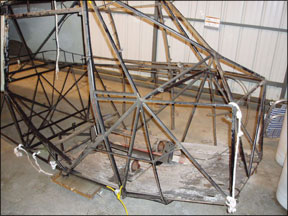
of pure pleasure flying, even though I know there are still a lot of working 12s towing gliders, signs, or even cropdusting. My Super Cruiser is a 1949 model. I purchased it three years ago and rebuilt it; I previously owned an Aztec. Times and missions had changed and I found myself punching holes in the clouds at 24 GPH, so decided that there should be a better and more economical way of doing that (and way more fun).
I sold the Aztec and bought a well-worn PA-12 with a doubtful O-290E 125-HP engine conversion. The engine was in lousy condition, so I replaced it with an overhauled 150-HP O-320A. As to any endeavor one commits to today, I began browsing the Web for advice. I found a priceless site on www.supercub.org, the place to look if you plan to or own any Cub model.
There I learned a bunch on mods and accessories and ended up putting on 26-inch bush wheels (along with 6-inch Cleveland wheels and brakes), a lightweight starter, vortex generators, drooped wingtips and PA-18 tail feathers and flaps. I re-pitched the prop to optimize climb performance, added shoulder harnesses, a transparent roof and door, new instrument panel, new seats and PA-18 trim system. These mods are STCd, but one thing brings another, as the heavier engine needs the bigger to be installed. This needs another trim system to move it, so plan accordingly!
After all this, a strange combination of the bigger engine and the original carburetor air box began to act up, producing a 200 to 300 RPM drop on takeoff only on humid days, always at the same point: roughly at 200 to 300 feet. This was solved by modifying the air filter to the cylindrical PA-18 type. Induction ice on takeoff? You bet!
For the record, the airplane as it was, plus all the mods, including labor that here goes for about one-third of what you pay in the U.S., totaling roughly $50,000. This includes $17,000 for the engine and accessories exchange.
Now I have the ultimate toy, dirt simple, with a nice big rear seat, can take off and land in less than 300 feet and have a great fun as cheap as it can be!
Maximo Verrascina,
Buenos Aires, Argentina

